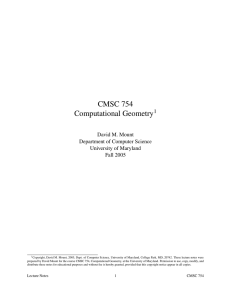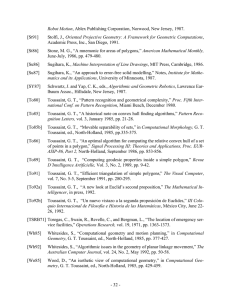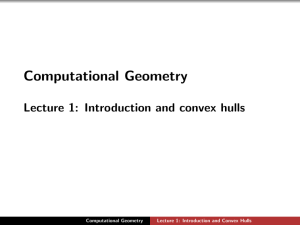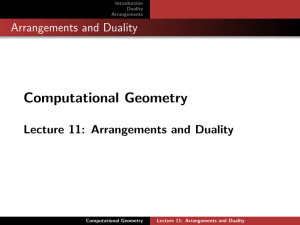Tentative Syllabus CSE680, Computational Geometry
advertisement
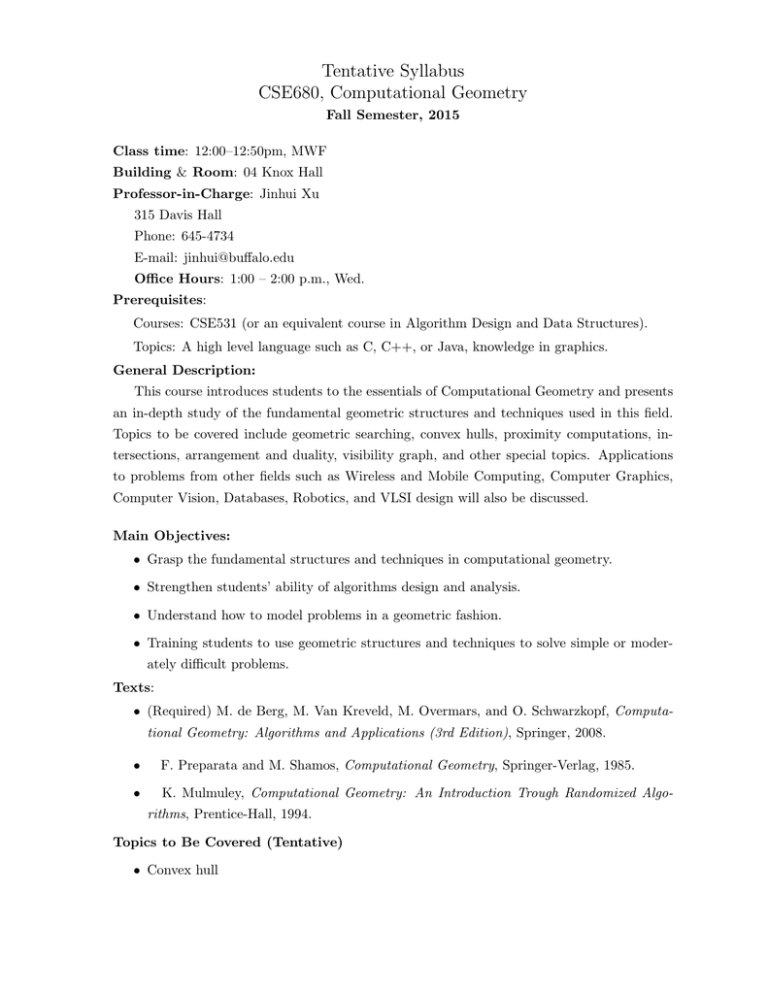
Tentative Syllabus CSE680, Computational Geometry Fall Semester, 2015 Class time: 12:00–12:50pm, MWF Building & Room: 04 Knox Hall Professor-in-Charge: Jinhui Xu 315 Davis Hall Phone: 645-4734 E-mail: jinhui@buffalo.edu Office Hours: 1:00 – 2:00 p.m., Wed. Prerequisites: Courses: CSE531 (or an equivalent course in Algorithm Design and Data Structures). Topics: A high level language such as C, C++, or Java, knowledge in graphics. General Description: This course introduces students to the essentials of Computational Geometry and presents an in-depth study of the fundamental geometric structures and techniques used in this field. Topics to be covered include geometric searching, convex hulls, proximity computations, intersections, arrangement and duality, visibility graph, and other special topics. Applications to problems from other fields such as Wireless and Mobile Computing, Computer Graphics, Computer Vision, Databases, Robotics, and VLSI design will also be discussed. Main Objectives: • Grasp the fundamental structures and techniques in computational geometry. • Strengthen students’ ability of algorithms design and analysis. • Understand how to model problems in a geometric fashion. • Training students to use geometric structures and techniques to solve simple or moderately difficult problems. Texts: • (Required) M. de Berg, M. Van Kreveld, M. Overmars, and O. Schwarzkopf, Computational Geometry: Algorithms and Applications (3rd Edition), Springer, 2008. • F. Preparata and M. Shamos, Computational Geometry, Springer-Verlag, 1985. • K. Mulmuley, Computational Geometry: An Introduction Trough Randomized Algorithms, Prentice-Hall, 1994. Topics to Be Covered (Tentative) • Convex hull • Line segment intersection, • Triangulation • Linear programming • Range search • Point location • Voronoi diagram • Arrangement and duality • Visibility graph • Well separated pair decomposition • VC-dimension, -approximation, and -nets. Course Work and Grading: Homework∗ : 20% Project: 15% Midterm : 25% Final: 35% Class Attendance: 5% ∗ No late homework will be accepted. Students are allowed, but not encouraged, to discuss the assignments. No student is allowed to look at another student’s solutions from any written source. If a solution is obtained from a group discussion, all students should list in their homeworks the names in the group. If a solution is obtained from other sources (e.g., websites, papers, books), students should give explicit reference to these sources in his/her homework. A solution obtained in the above two ways could receive discounted points. Those who fail to follow these rules will be treated as cheating. If anyone is in doubt, please consult the Professor-in-Charge for clarification. Note: Each component will receive a numerical score. The course grade will be based on the weighted total of all components and the class curve. Class participation includes attendance, participation in class discussions, and general interest towards the course material. The exams will be closed-book, and closed-notes. Academic Integrity Policy: No cheating and plagiarism are allowed in homeworks, and exams. Those found violating academic integrity will get an immediate F in the course, and further actions, consistent with the Department’s Academic Integrity Policy, will be taken against them.


